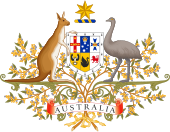Flags Act 1953
| Flags Act 1953 | |
|---|---|
 | |
| Parliament of Australia | |
| |
| Royal assent | 14 February 1954 |
| Commenced | 14 April 1954 |
| Introduced by | Robert Menzies |
| Status: Amended | |
The Flags Act 1953 is an act of the Parliament of Australia which defines the official Flag of Australia. Queen Elizabeth II gave Royal Assent on 14 February 1954 after opening the Commonwealth Parliament during her 1954 Royal Tour. It was the first of the few Commonwealth Statutes enacted by the reigning Monarch.
Flags Act 1953

The legislation specifies the colours and construction details for the Australian National Flag and the Australian Red Ensign (also known as the Australian Merchant Flag). Sections 5 & 6 confer statutory powers on the Governor-General to appoint 'flags and ensigns of Australia', and authorise warrants and make rules as to use of flags. Section 8 ensures that the 'right or privilege' of a person to fly the Union Jack is not affected by the Act.
The Act originally contained a serious drafting error in Table A of the Act. The outer diameter of the Commonwealth Star was recorded as being three-eighths of the width of the flag, instead of the true value of three-tenths of the width of the flag. The Act was amended to correct the error in 1954.
Upon introducing the legislation in the House of Representatives on 20 November 1953, Prime Minister Robert Menzies stated:
"The bill is very largely a formal measure which puts into legislative form what has become almost the established practice in Australia."[1]
Flags Amendment Act 1998
The Flags Amendment Act was passed after the 1996 Australian federal election, during a period where the republican movement was influential, and both the government and opposition parties were committed to bringing the issue to a head as a matter of policy. The Flags Amendment Act 1998 added to section 3 of the Flags Act and provided that the present Australian National Flag could only be replaced if a majority of State and Territory electors qualified to vote for the House of Representatives agree. It was promoted by its supporters as "ensuring a degree of protection for"[2] and "the first substantive parliamentary steps towards defining a process for the change of"[3] the Australian National Flag.
Criticism
During parliamentary debate in the House of Representatives over the Flags Amendment Bill 1996, Laurie Ferguson MP, Member for Reid, whilst supporting the legislation, raised concerns that, "...whilst the bill cements the idea of a plebiscite, with people being consulted in a manner similar to the consultation on the change to the national anthem, one of the weaknesses of the bill is that it does not set out any long-term process for the consideration of change." Referring to the fact that a future parliament may rescind or even ignore the amendment "...in theory, it is not quite what it is cracked up to be in so far as, theoretically, a new government can alter it at any stage."[4]
The Australian Flag Society has proposed a National Language, Holiday and Flag Bill, as the way forward in response to a petition of certain citizens calling for a parliamentary committee to review the Flags Act 1953 (Cth).[5][6][7] It proposes to amend the Commonwealth of Australia Constitution Act 1900 (IMP) by way of modifiable provisions declaring, among other things, the existing flag to be the Australian National Flag.
Under the proposed legislative and constitutional refinements, it is envisaged that the Flags Act would remain on the statute books, to provide the construction sheet for the Australian National Flag which would be described in terms of its essential elements in the constitution, thereby settling the question of popular sovereignty in relation to the process for reviewing the design – in whole or in part – with a weighty body of legal opinion against the constitutionality of the current statutory rules in subsections 3(2) & (3),[8][9] which provide for an instant-runoff for choosing between the existing flag and one or more alternatives, on the basis of universal suffrage. As the device occupying the lower hoist is simply referred to as a "large white Commonwealth Star", the number of points on what is a well recognised heraldic symbol in its own right[10] could be varied by ordinary legislation, according to changes in membership of the Australian Federation, and not by a plebiscite as currently required, which would remove what has been criticised as an "anomalous and costly" impediment.[11]
References
- ^ https://www.anfa-national.org.au/history-of-our-flag/flag-acts-1953-statute/robert-menzies-speech/
- ^ https://www.anfa-national.org.au/wp-content/uploads/2018/03/Newsletter-1998.pdf
- ^ http://www.ausflag.com.au/government_accepts_advice.asp
- ^ http://www.ausflag.com.au/parliamentary_debates_laurie_fergusion.asp
- ^ "Archived copy". Archived from the original on 10 April 2012. Retrieved 22 May 2012.
{{cite web}}: CS1 maint: archived copy as title (link) - ^ "Archived copy". Archived from the original on 10 March 2012. Retrieved 22 May 2012.
{{cite web}}: CS1 maint: archived copy as title (link) - ^ http://www.norepublic.com.au/index.php?option=com_content&task=view&id=2504&Itemid=39
- ^ http://www.ausflag.com.au/government_accepts_advice.asp
- ^ http://www.ausflag.com.au/government_to_preserve_flag.asp
- ^ http://www.ausflag.com.au/reply_to_ausflag_letter.asp
- ^ http://www.ausflag.com.au/open_letter_to_the_pm.asp
External links
- National Archives of Australia. Flags Act 1953
- Australian Parliamentary Library. Flags Amendment Bill 1996
